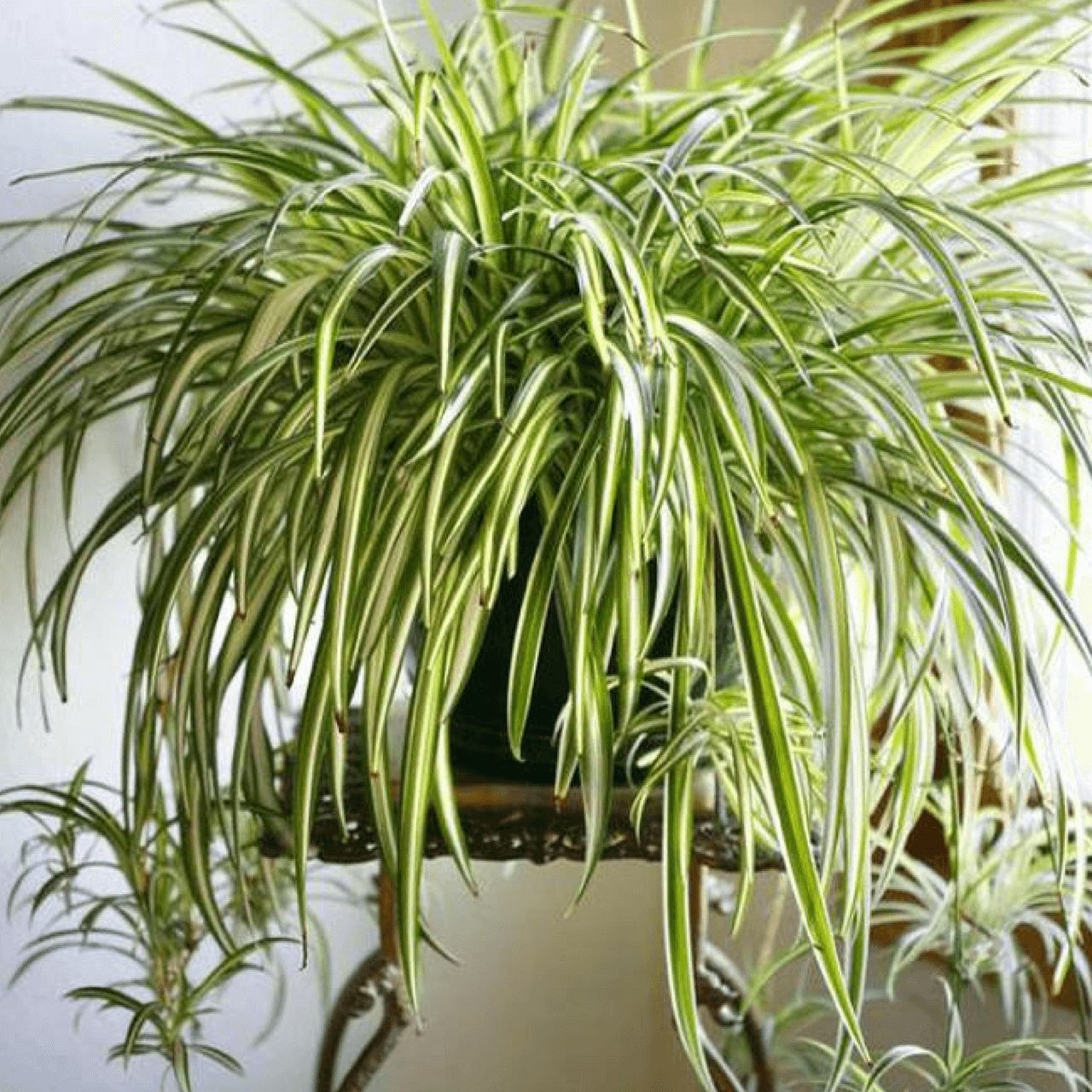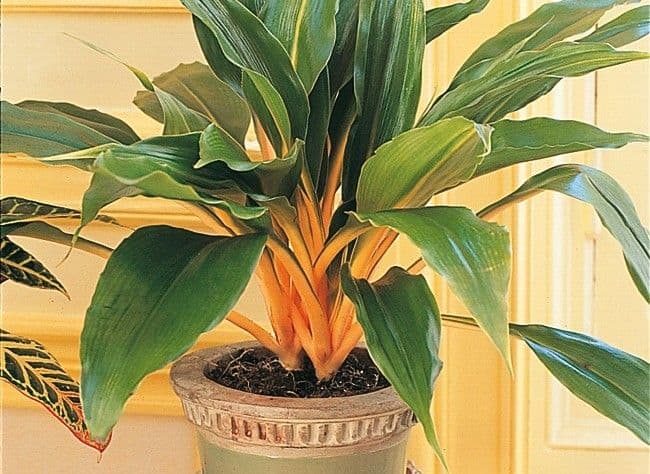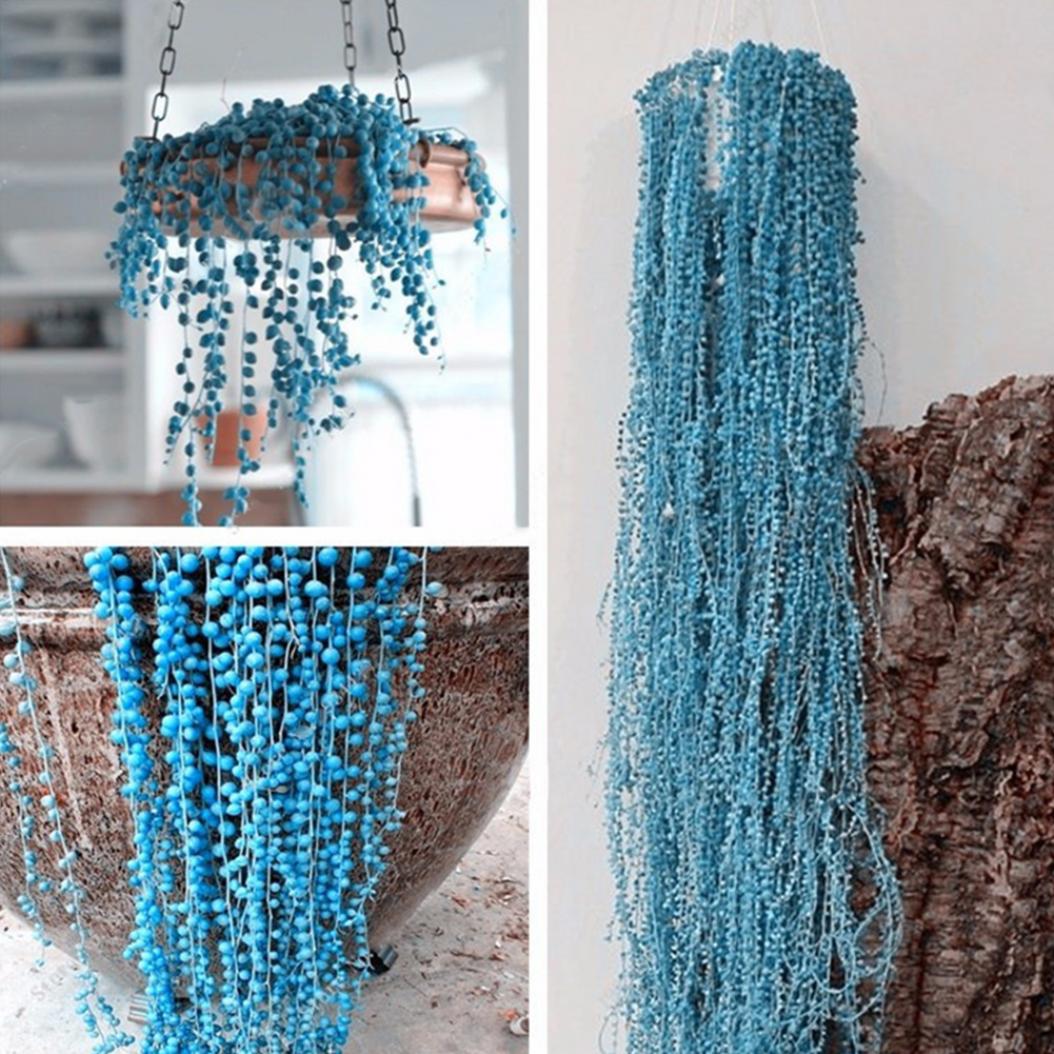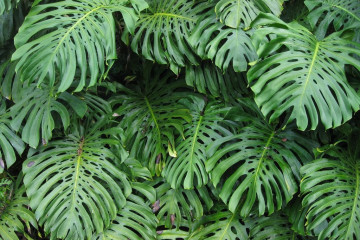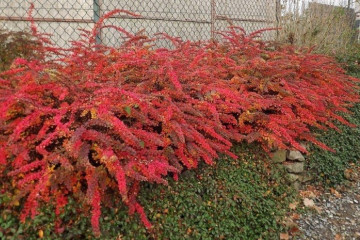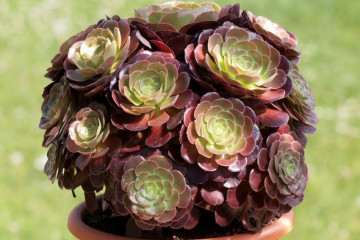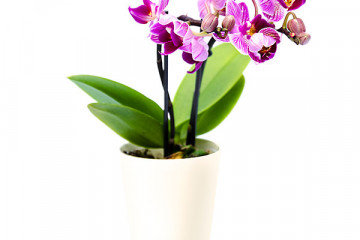Chlorophytum - species Green Orange, winged, green, Laxum
Content:
The lush green lush rosette of long arched leaves is chlorophytum. This plant can be found everywhere, recently it often decorates city flower beds. They recognize its varieties by long mustache, on the tips of which bunches of small bushes of children huddle.
Description of the plant
The green bush belongs to the Liliaceae family, it lives in all the tropics, but its true homeland is South Africa. Tall bushes grew there along the banks of rivers and reservoirs, they are great lovers of moisture and sun.
At the same time, these plants are distinguished by unprecedented resistance to unfavorable conditions of a temporary nature: they are not afraid of temperature drops and a decrease in temperature down to 8 ° C. They will survive drought remarkably, retaining moisture in their fleshy roots. They grow both on windows and on shaded cabinets or tables.
Is it possible to keep chlorophytum at home
The flower is recognizable, got such popularity because of its unpretentiousness. It is easy to grow and propagate. It will be an excellent start in the cultivation of representatives of the flora for a novice florist, decorate offices, schools, hospitals.
Sometimes they ask a question about chlorophytum for the home: is it good or bad to grow it in a home. The owner of the oldest roots, along with the fern, indoor chlorophytum is an excellent filter of magnetic and biofields, it fills the room with a favorable aura and protects from computer and mobile radiation.
The owner of green foliage purifies the air and moisturizes it, and it is not poisonous, as many on the Internet write. With abundant watering, its long leaves evaporate excess moisture. It has the ability to absorb carbon dioxide compounds harmful to humans from the air. It is an indispensable assistant in landscaping apartments located near roads, as well as in any apartment near stoves and heating boilers.
Chlorophytum: species
There are about 200 species in the chlorophytum family. They are almost all similar in appearance and care. But there are also decorative varieties, distinguished by their beauty and breeding method.
Green Orange
An ornamental shrub that differs in appearance from its counterparts. Its glossy leaves are much darker and wider, and the leaf stalk is painted in a beautiful orange color, which smoothly passes into the central stripe of the leaf. The flower does not have a developed stem; its thick-leaved shoots form an elongated rosette. The leaf plate is not too long, the bush reaches a height of 35 cm.
He is unpretentious in care and requires the same conditions of detention as his relatives. The only thing to consider when keeping this species is the placement. This species is very sensitive to bright sunlight, which can burn its shiny leaves. In the summertime, it is better to rearrange it in the back of the room, but not in the shade.
Peduncles on a plant do not stay long. The flowers are white, collected in a cone-shaped spikelet, enveloped in a green leaf.The bloom looks very unusual.
Winged
The winged name comes from beautiful leaves that are not as long as the usual arches of chlorophytum, they are wide and on long cuttings. Chlorophytum is the winged progenitor of Orange, but only its cuttings can be not only orange. These bright representatives pamper their breeders with a contrasting palette. Cuttings and leaf piths are light yellow to dark crimson on dark green leaves.
A beautiful bright bush requires a lot of diffused light, which maintains the brightness of the exotic color. Its leaves are shiny, glossy like high humidity and regular spraying. In winter, it is important not to overflow or overdry the earthen lump. The flowers are as unusual as those of the previous species - a delicate spikelet with inflorescences arranged in a spiral.
Green
Cape Chlorophytum is a green bush without stripes. Its shoots are long and drooping, narrow, folded in half.
It grows wonderfully in flower beds and tolerates temperature changes in summer on the balcony and terrace. Often it can be seen as an ampelous plant in a flowerpot or on the walls. The size of his bush often reaches 80 cm in height and 50 cm in diameter. He can stand all winter and on the windowsills. And in summer, with too bright rays of the sun, it can get burns on the window. In this case, areas of the foliage will be discolored and have a silvery sheen.
Laxum
Rare chlorophytum for Russian apartments. It can be purchased in stores or by mail order directly from Dutch greenhouses. And there he was pampered, so much so that in apartment conditions he does not always grow successfully. Another not very successful advantage is the lack of familiar children. Its bloom is similar to the bloom of winged chlorophytum - in the form of a spikelet.
But, nevertheless, the flower is very beautiful. Its rosette consists of long green leaves with a thin white edging. This color looks very impressive and decorative, which deserves the love of breeders. The flowering is beautiful, unusual, with white flowers gathered in a spikelet.
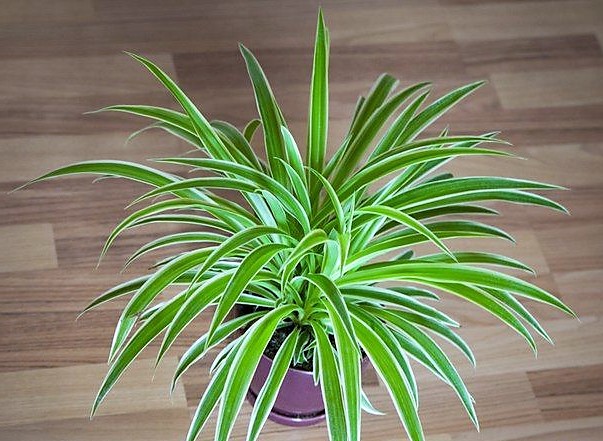
It will be whimsical in care, since greenhouse cultivation does not forget, which means that it will be picky about sufficient lighting and moisture
Curly
Frequent visitor to schools, hospitals and other government agencies, like Tradescantia. An unpretentious flower can create a real holiday on the windowsill. His curly striped hair pleases the eye, purifies the air and gives calmness and relaxation of the situation. It grows quickly, filling the entire diameter of the pot with its rosettes. Its not too long leaves are decorated with white and silver stripes in the center of the entire length of the leaf plate. Leaves curl and bend beautifully in an arc. He really curls along with the peduncles, which also have intricate shapes.
The second name of this chlorophytum is Bonnie curly. To grow a real curly-haired handsome man, it is enough to pay attention to him during the active period of growth in the summer. Care for curly chlorophytum is a drinking regimen and light. He will be grateful for daily spraying, and once every two weeks, bathing and feeding. Watering is needed after half of the soil in the pot has dried. The light is diffused, but in sufficient quantity, otherwise the leaves will fade, and the white decorations will become narrower.
Pearl
Since the beginning of online sales, it has become increasingly common to encounter deception. So chlorophytum was not spared by marketers who want to get profit fraudulently. First of all, a new type of Chlorophytum Pearl was invented. And the most terrible deception was that he was assigned a subspecies - Blue Pearl, which in the photo depicted a plant of bright blue color, both shoots and foliage.
In fact, the plant that is attributed to the Pearl variety and belongs to the chlorophytum family is called Rowley's Ragwort, or another name is pearl thread. Yes, the plant is definitely very unusual and beautiful. It resembles beads with its round leaves on thin strings. But the rootwort is not a brother to chlorophytum.
When and how Chlorophytum blooms
The absence of flowers can be for two reasons:
- insufficient lighting;
- untimely transplant.
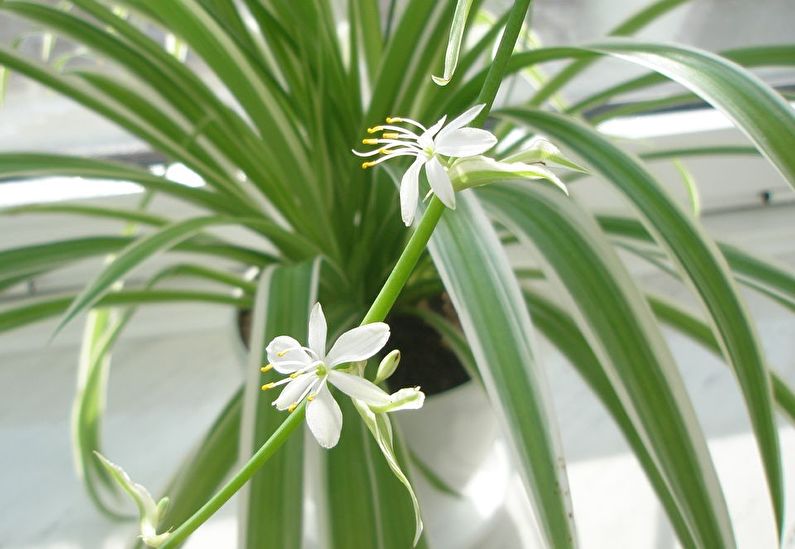
The vegetative period of the plant is active, very rarely, when the flower does not bloom for a long time
Transplanting is necessary to renew the soil by transferring it to a larger pot. During transplantation, it is important to examine the roots and remove all damaged ones, as they accumulate moisture, there is a high risk of rotting of the processes. Also, sometimes the tips of the leaves begin to turn black, which is also a sign of overflow of the plant.
Usually, after a spring transplant, two weeks later, the plant releases the first arrows of the peduncles. An indicator of a healthy plant will be the thickness and length of this shoot.
Different varieties bloom in different ways, but they are all united by the unsightly flowers. Chlorophytum is a deciduous ornamental plant that is not a beautifully flowering plant.
- Cape chlorophytum does not bloom at all at home. It reproduces by dividing the root and by babies that grow directly on the rosette of the flower.
- The striped and crested chlorophytums produce long shoots on which snow-white flowers with yellow stamens are arranged in a spiral. They are cute, but inconspicuous in comparison with the green fountain of lush greenery. After flowering, small bushes of children appear on the tips of the shoots of curly chlorophytum. They will soon acquire aerial roots and can live on maternal shoots for a long time. Crested varieties raise babies from leaf sinuses.
- Exotic and unusual varieties of chlorophytum, such as Orange, Laxum and Chlorophytum Ocean or Ocean, bloom with unusual ears of light yellow or greenish flowers.
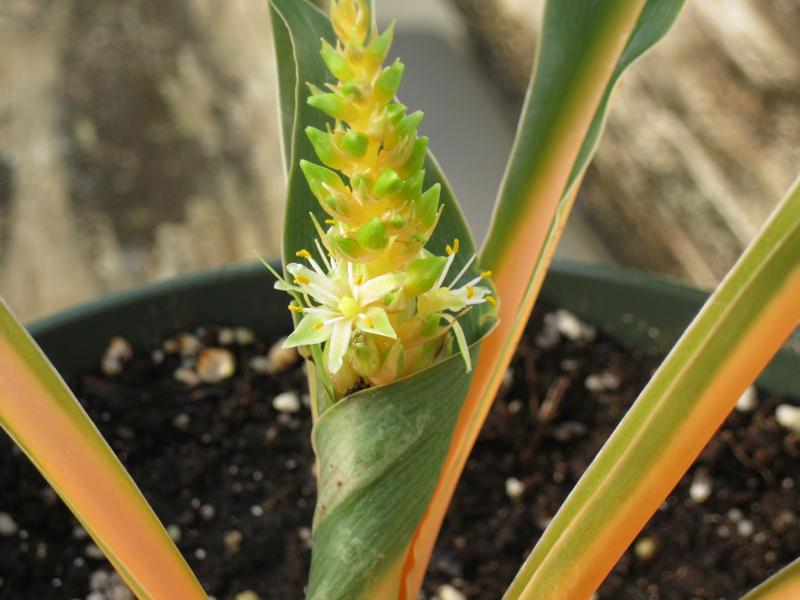
This interesting spikelet appears as if from a new leaf, which envelops it until the end of flowering.
Chlorophytum is ideal for beginner growers and is loved by experienced breeders. Its unpretentiousness and decorativeness won the love of designers who use these green fountains in outdoor compositions. In the house, this phyto-friend will benefit from air purification and a minimum of hassle in leaving.
